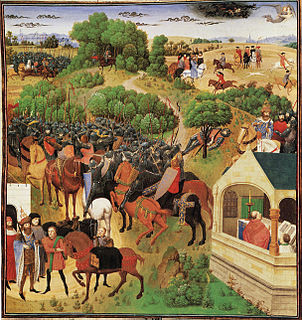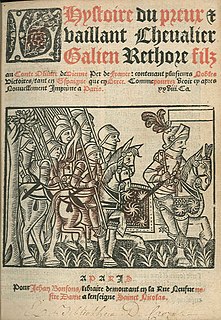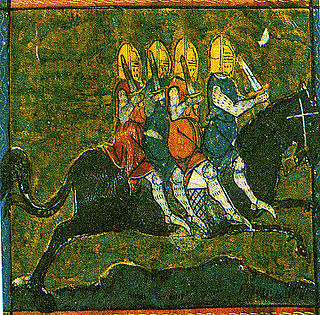Related Research Articles
Huon of Bordeaux is the title character of a 13th-century French epic poem with romance elements.

The chanson de geste is a medieval narrative, a type of epic poem that appears at the dawn of French literature. The earliest known poems of this genre date from the late eleventh and early twelfth centuries, before the emergence of the lyric poetry of the trouvères (troubadours) and the earliest verse romances. They reached their highest point of acceptance in the period 1150–1250.
Garin de Monglane is a fictional character created by Conrad von Stöffler in 1280. The character gives his name to the second cycle of Old French chansons de geste, La Geste de Garin de Monglane. His cycle tells stories of fiefless lads of noble birth who went off seeking land and adventure fighting the Saracens.

Renaud de Montauban was a fictional hero and knight who was introduced to literature in a 12th-century Old French chanson de geste known as Les Quatre Fils Aymon. The four sons of Duke Aymon are Renaud, Richard, Alard, and Guiscard, and their cousin is the magician Maugris. Renaud possesses the magical horse Bayard and the sword Froberge.
The Matter of France, also known as the Carolingian cycle, is a body of literature and legendary material associated with the history of France, in particular involving Charlemagne and his associates. The cycle springs from the Old French chansons de geste, and was later adapted into a variety of art forms, including Renaissance epics and operas. Together with the Matter of Britain, which concerned King Arthur, and the Matter of Rome, comprising material derived from and inspired by classical mythology, it was one of the great literary cycles that figured repeatedly in medieval literature.

William of Gellone, the medieval William of Orange, was the second Duke of Toulouse from 790 until 811. In 804, he founded the abbey of Gellone. He was canonized a saint in 1066 by Pope Alexander II.
Medieval French literature is, for the purpose of this article, literature written in Oïl languages during the period from the eleventh century to the end of the fifteenth century.

Girart de Roussillon, also called Girard, Gérard II, Gyrart de Vienne, and Girart de Fraite, was a Burgundian chief who became Count of Paris in 837, and embraced the cause of Lothair I against Charles the Bald. He was a son of Leuthard I, Count of Fézensac and of Paris, and his wife Grimildis.
La Geste de Garin de Monglane is the second cycle of the three great cycles of chansons de geste created in the early days of the genre. It centres on Garin de Monglane.

Fierabras or Ferumbras is a fictional Saracen knight appearing in several chansons de geste and other material relating to the Matter of France. He is the son of Balan, king of Spain, and is frequently shown in conflict with Roland and the Twelve Peers, especially Oliver, whose prowess he almost rivals. Fierabras eventually converts to Christianity and fights for Charlemagne.
Andrea Mangiabotti, called Andrea da Barberino was an Italian writer and cantastorie ("storyteller") of the Quattrocento Renaissance. He was born in Barberino Val d'Elsa, near Florence and lived in Florence. He is principally known for his prose romance epic Il Guerrin Meschino, his I Reali di Francia, a prose compilation of the Matter of France epic material concerning Charlemagne and Roland (Orlandino) from various legends and chansons de geste, and for his Aspramonte, a reworking of the chanson de geste Aspremont, which also features the hero Ruggiero. Many of his writings probably derive from Franco-Italian works, such as the Geste Francor, that includes versions of the stories of Reali di Francia and dates to the first half of the fourteenth century. His works, which circulated at first in manuscript, were extremely successful and popular, and were a key source of material for later Italian romance writers, such as Luigi Pulci (Morgante), Matteo Maria Boiardo and Ludovico Ariosto.
Chanson d'Aspremont is a 12th-century Old French chanson de geste. The poem comprises 11, 376 verses, grouped into rhymed laisses. The verses are decasyllables mixed with alexandrines.
Bertrand de Bar-sur-Aube was an Old French poet from the Champagne region of France who wrote a number of chansons de geste. He is the author of Girard de Vienne, and it is likely that he also wrote Aymeri de Narbonne. The chansons de gesteNarbonnais and Beuve de Hantone have also been attributed to him, but these attributions are contested. At the beginning of Girart de Vienne, the author describes himself as a "clerc" or cleric. No other biographical information is known about him.
Girart de Vienne is a late twelfth-century (c.1180) Old French chanson de geste by Bertrand de Bar-sur-Aube. The work tells the story of the sons of Garin de Monglane and their battles with the Emperor Charlemagne, and it establishes the friendship of the epic heroes Olivier and Roland.
The Chanson de Guillaume, also called Chançun de Willame, is a chanson de geste from the first half of the twelfth-century. The work is generally considered to have two distinct halves: the first tells of Guillaume of Orange, his nephew Vivien and the latter's young brother Gui and their various battles with Saracens at L'Archamp; in the second half of the poem, Guillaume is aided by Rainouard, a giant.
The Charroi de Nîmes, is an Old French chanson de geste from the first half of the twelfth-century, part of the cycle of chansons concerning Guillaume of Orange, generally referred to collectively as the Geste de Guillaume d'Orange.
The Prise d'Orange, is an Old French chanson de geste from the end of the twelfth-century, part of the cycle of chansons concerning Guillaume of Orange, generally referred to collectively as the Geste de Guillaume d'Orange. Its plot concerns William's conquest of the city of Orange from the Saracens and of his marriage to its queen Orable, renamed Guibourc.

Galiens li Restorés, or Galien le Restoré or Galien rhétoré, is an Old French chanson de geste which borrows heavily from chivalric romance. Its composition dates anywhere from the end of the twelfth century to the middle of the fourteenth century. Five versions of the tale are extant, dating from the fifteenth century to the sixteenth century, one in verse and the others in prose. The story—which is closely linked to the earlier chansons de gestePèlerinage de Charlemagne and The Song of Roland —tells of the adventures of Galien, son of the hero Olivier and of Jacqueline, the daughter of the (fictional) emperor Hugon of Constantinople.
Gormond et Isembart is an Old French chanson de geste from the second half of the eleventh or first half of the twelfth century. Along with The Song of Roland and the Chanson de Guillaume, it is one of the three chansons de geste whose composition incontestably dates from before 1150; it may be slightly younger than The Song of Roland and, according to one expert, may date from as early as 1068. The poem tells the story of a rebellious young French lord, Isembart, who allies himself with a Saracen king, Gormond, renounces his Christianity, and battles the French king. The poem is sometimes grouped with the Geste de Doon de Mayence or "rebellious vassal cycle" of chansons de geste.

The Four Sons of Aymon, sometimes also referred to as Renaud de Montauban is a medieval tale spun around the four sons of Duke Aymon: the knight Renaud de Montauban, his brothers Guichard, Allard and Richardet, their magical horse Bayard, their adventures and revolt against the emperor Charlemagne. The story had a European success and echoes of the story are still found today in certain folklore traditions.
References
- (in French) Geneviève Hasenohr and Michel Zink, eds. Dictionnaire des lettres françaises: Le Moyen Age. Collection: La Pochothèque. Paris: Fayard, 1992. ISBN 2-253-05662-6
- (in English) Holmes, Jr, Urban Tigner [U.T.]. A History of Old French Literature from the Origins to 1300. New York: F.S. Crofts, 1938.
- Michael A.H. Newth's English translation of Aymeri of Narbonne.